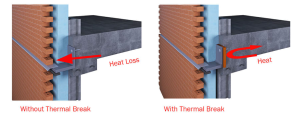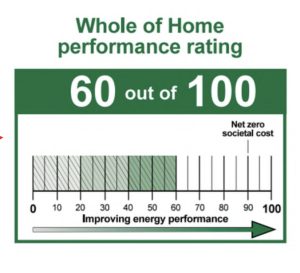What do the NCC 2022 energy efficiency provisions mean?
Powerhaus aim to help you get the best energy efficiency results for your design, and that means navigating the building code. This summary aims to help you understand the headline energy efficiency and condensation changes in the NCC 2022 updates, but more importantly, to understand how they will impact designing and building homes in the cooler climates of Australia.
[ez-toc]
Summary
These changes apply to new homes. Renovations and extensions have special conditions in most states and territories.
- Minimum star rating moves from 6 stars to 7 stars
- Star ratings will now include the impact of thermal bridging, relevant to steel structures
- Introduction of whole-of-home, a new yearly energy budget for all houses. All major electrical loads will be modelled, and the standard required is met through increasing appliance efficiency or ‘offsets’ via solar.
- New condensation management provisions:
- Class 3 or 4 wall wrap mandatory in climate zones 6, 7 and 8 (Canberra, most of Victoria, southern NSW and Tasmania)
For dates on when this will apply to you, see our post here, but here’s a summary for cool climate states:
- NSW 1 Oct 2023
- ACT 15 Jan 2024
- VIC 1 May 2024
- SA 1 Oct 2024
- TAS – not adopted
These changes apply to houses, townhouses and apartments (Class 1 buildings, Class 2 sole-occupancy units and Class 4 parts of buildings).
Up-skilling with your team for NCC 2022? Schedule a call, CPD workshop or toolbox talk – it’s complementary. All queries welcome – we can schedule tailored support as you require.
Want more detail? Here’s our comprehensive summary of the NCC 2022 energy efficiency and condensation management provisions that apply to residential homes, together with how we see these changes impacting the design and building details of cooler climates.
Main NCC 2022 energy efficiency provisions
New minimum star rating of 7 stars, and changes to star rating bands
Headline change: The minimum star rating for new homes is increasing from 6 stars to 7 stars. This means new homes will be approximately 25% more efficient overall and use 25% less energy for heating and cooling.
- We welcome these changes, as they will ensure that homeowners get more comfortable homes that are better designed for future climate and energy demand.
- It is harder to meet these standards when you live in colder, inland climates of Australia: southern NSW, Victoria and the ACT. How do we know? We modelled the same four plans for every climate in Australia as part of the Government’s Your Home free house plans.
- However, the star band heating and cooling ranges have also changed, making it slightly easier to achieve the 7 stars and higher ratings. The new 7 stars is roughly equivalent to 6.5-6.8 stars in the previous climate ranges.
- The star bands were changed as the climate files that are used in thermal models of homes were updated to reflect more recent climate data.
Our insight:
Getting 7 stars can be challenging. The design becomes more important. Ensure that you get your key solar passive design ratios right (see how the Powerhaus app guides you through), and your house has an excellent chance of reaching 7 stars.
Reference: NCC 2022 Section 13
Thermal bridging included in star ratings
Headline change: Star ratings will now include the impact of thermal bridging. This will primarily impact steel framed homes.
- Thermal bridging describes a situation in a building where there is a direct connection between the outside and inside through a conductive element. The most conductive elements in Australian homes are steel frames and aluminium window frames.
- What impact will this have on star ratings?
- For timber framed houses, it has very little impact and may reduce the star rating 0.1-0.2 stars.
- For steel framed houses, the impact to the rating will be high – reducing the rating by around 1 star in cold climates, and 0.3 in warmer climates.
- Steel frames conducts heat and cool, which reduces the comfort of homes and requires you to use more heating and cooling.
- To prevent thermal bridging in steel structures, there are a two main options:
- Provide an additional continuous layer of insulation over the frame, and
- Provide extra insulation attached to the frame.
There are currently two tape products designed to attach to steel frames using an adhesive backing (ThermaTape and HardieBreak) and create a thermal break where two layers of stell construction contact each other. Both products have an R-value of R0.2 – not enough for thermal bridging mitigation. We hope to see more products come to market as thermal bridging becomes recognised within the NCC 2022.
Our insight:
Thermal breaks are particularly important for cool climates including Canberra, southern NSW, Melbourne and Tasmania. Why? Not only will it prevent heat loss during winter, it will prevent condensation and mould growth in your walls – keeping your house healthy and safe.

Whole of home yearly energy budget introduced
Headline change: Whole of home is a brand-new part of the energy efficiency process and captures appliance energy use as well as solar generation. Although it’s important to consider the energy use of the whole house, allowing solar to offset energy demand is a simplistic over-generalisation.
- Whole-of-home considers all the energy needs of the house: lighting, hot water, heating and cooling, plus swimming pool and spa pumps. It also considers the efficiency of the appliances you are installing.
- This means that final appliance choices will need to be included when finalising energy efficiency or NatHERS ratings for new homes. We will include default assumptions in any preliminary assessment.
- Each home will need to get a minimum rating of 60/100. This can generally be achieved by adding solar, which ‘offsets’ your energy use.
Note: NSW will have an updated BASIX process, not Whole-of-Home.
Our insight:
It remains to be seen what impact whole-of-home will have on homeowner choices. Powerhaus are already helping our clients connect their thermal performance with their energy demand through the Australian-first NatHERS app, and we’re confident of empowering clients to make good choices here.

Reference: NCC 2022 Section 13.6
Some states are all-electric
Whole-of-home assesses both electric and gas appliances. Although not part of Whole-of-Home, it’s worth noting that some states are also requiring new homes to go all electric.
- ACT: all new homes are all-electric
- VIC: all new homes electric-only from 2024
Our insight:
We fully support the move to all electric homes. Gas creates poor air-quality outcomes within homes and surrounds as well as contributing to climate change. Going all-electric with good design and solar power will help homeowners save money and the planet.
Slab and slab-edge insulation, and in-slab heating
Headline changes:
- All slabs require under-slab and slab-edge insulation of R0.64.
- If there is in-slab heating, the slab must have slab-edge insulation R1 or higher.
- Slab-on-ground (excluding waffle pod) in climate zone 6&7 should have insulation underneath and on the edge of minimum R 0.64 and in climate zone 8 minimum R1 to the edge and R2 underneath.
- Insulating the slab where there is in-slab heating is important. If you’re using in-slab heating, you’re generally in a cold climate. This means that the ground temperature will be colder than ideal, and insulating your slab from the ground temperature will save you money and create a ‘heat bank’, keeping your house warmer.
Reference: NCC 2022 Section 13.2.6
NCC 2022 condensation management provisions
Wall wraps
Headline change: Vapour-permeable wraps equivalent to a class 3 or 4 membrane are now mandatory for climate zones 4-8 (i.e. most of Victoria, ACT, southern NSW and Tasmania).
- Climate zones 4 and 5 will need a Class 3 vapour permeable wrap
- Climate zones 6-8 will need a Class 4 vapour permeable wrap
- The wrap must be separated front the external building material by a drained cavity. When introducing a vapour permeable wrap, it is important to build a small cavity–minimum 20mm–between the external cladding and the wrap, to ensure that condensation can run down and exit the cavity – do not direct fix.
- Although the wrap will not impact the energy rating, the small drainage cavity may have a slight, positive impact on the star rating.
Our insight
This change in mandatory wall wraps is crucial for healthy homes. In general, we would always recommend that you use an air-tight, vapour permeable wrap. Increasing airtightness is not currently included in the NCC (although we hope it will in future!), but it is one of the highest cost-benefit measures when building a new home.

Reference: NCC 2022 Section 10.8.1
Roof ventilation and sarking changes
Climate zones 6,7 and 8 must
- have a ventilated roof space of not less than 20 mm. The space must be directly above the insulation, or above the sarking which is immediately above the insulation.
- ventilate the roof (or have a tiled roof without sarking), such as via whirlybirds or ridge/eave vents.
This does not apply to roofs made of concrete, structurally insulated panels or subject to bushfire attack level FZ.
Reference: NCC 2022 Section 10.8.3
If you’ve got more questions about implementing 7 stars, or finding out about how to ensure you meet the new provisions, talk to our team about our solutions-focused process or request a quote to get a job underway today.
Sign up for best practice energy efficiency and building science for Australian homes.








